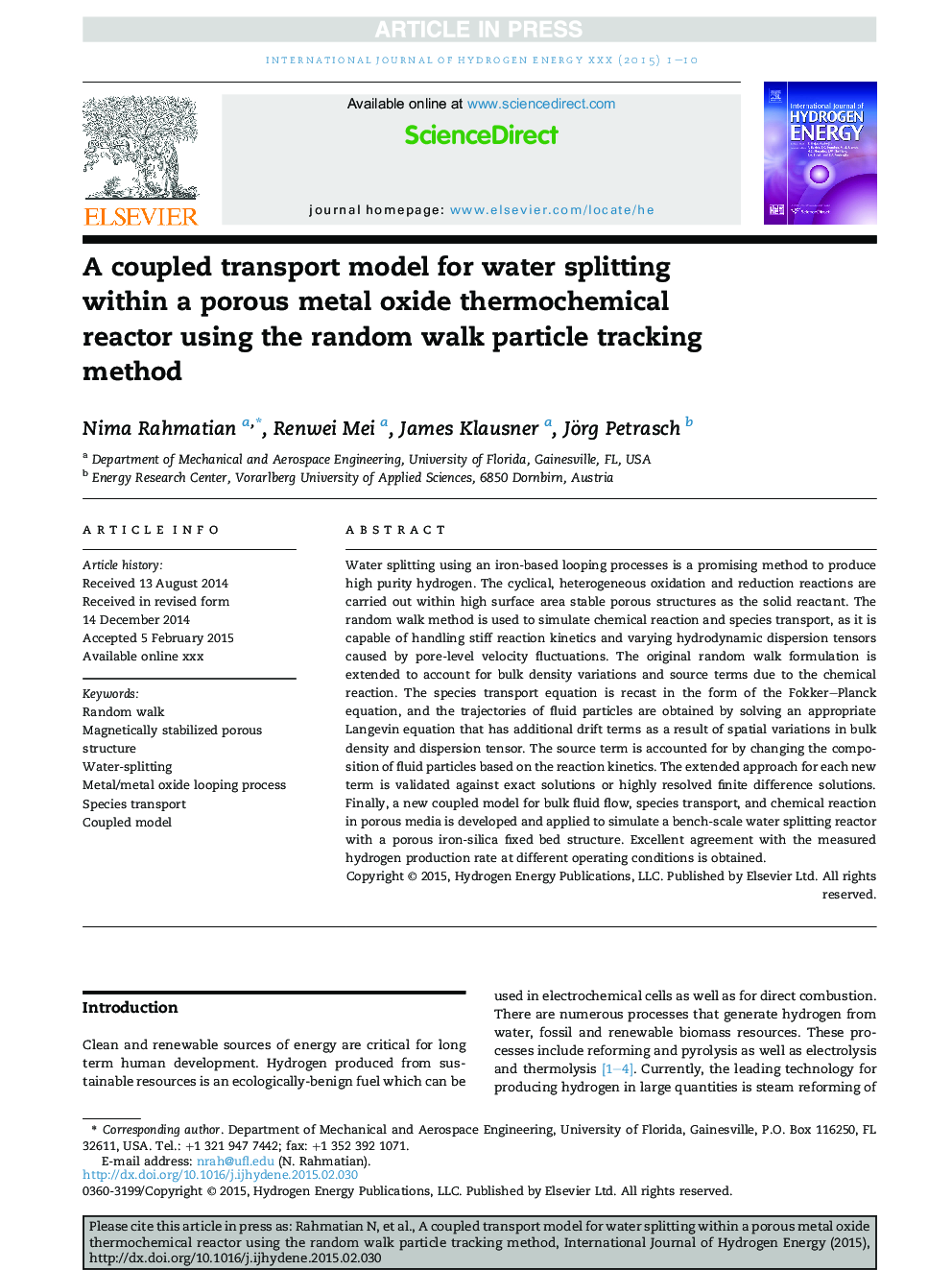| کد مقاله | کد نشریه | سال انتشار | مقاله انگلیسی | نسخه تمام متن |
|---|---|---|---|---|
| 7715796 | 1497460 | 2015 | 10 صفحه PDF | دانلود رایگان |
عنوان انگلیسی مقاله ISI
A coupled transport model for water splitting within a porous metal oxide thermochemical reactor using the random walk particle tracking method
ترجمه فارسی عنوان
یک مدل انتقال همراه برای تقسیم آب در یک راکتور ترموشیمیایی اکسید متخلخل با استفاده از روش ردیابی قطرات تصادفی
دانلود مقاله + سفارش ترجمه
دانلود مقاله ISI انگلیسی
رایگان برای ایرانیان
کلمات کلیدی
پیاده روی تصادفی، ساختار متخلخل مغناطیسی تثبیت شده، تقسیم آب، فرآیند حلقه اکسید فلزی / فلز، حمل و نقل گونه، مدل همپوشانی،
ترجمه چکیده
تقسیم آب با استفاده از فرایندهای حلقه ای مبتنی بر آهن یک روش امیدوار کننده برای تولید هیدروژن خلوص بالا است. واکنش های اکسیداسیون و واکنش های ناپایدار، در داخل سطوح بالا، سازه های متخلخل پایدار را به عنوان واکنش جامد انجام می دهند. روش پیاده روی تصادفی برای شبیه سازی واکنش شیمیایی و انتقال گونه ها مورد استفاده قرار می گیرد، زیرا قادر به حرکت سینتیک واکنش های شدید و تنش های پراکندگی هیدرودینامیکی است که ناشی از نوسانات سرعت خورشید است. فرمول اصلی راه رفتن به صورت تصادفی به دلیل تغییرات چگالی فله و اصطلاحات منبع به دلیل واکنش شیمیایی به حساب می آید. معادله انتقال گونه ای به صورت معادله فوکر-پلانک دوباره تولید می شود و مسیرهای ذرات مایع با حل یک معادله لانژین مناسب است که دارای تغییرات مکانی در تراکم فله و تانسور پراکندگی است. اصطلاح منبع، با تغییر ترکیب ذرات مایع بر اساس سینتیک واکنش، به حساب می آید. رویکرد توسعه یافته برای هر یک از اصطلاحات جدید در مقایسه با راه حل های دقیق و یا راه حل های بسیار متناقض محدود، معتبر است. در نهایت، یک مدل جدید همراه برای جریان سیال فله، حمل و نقل گونه و واکنش شیمیایی در رسانه های متخلخل توسعه داده شده است و برای شبیه سازی یک رآکتور تقسیم آب مقیاس با یک ساختار ثابت بستر آهن متخلخل سیلیکا متصل شده است. توافق عالی با سرعت تولید هیدروژن تولید شده در شرایط عملیاتی مختلف بدست می آید.
موضوعات مرتبط
مهندسی و علوم پایه
شیمی
الکتروشیمی
چکیده انگلیسی
Water splitting using an iron-based looping processes is a promising method to produce high purity hydrogen. The cyclical, heterogeneous oxidation and reduction reactions are carried out within high surface area stable porous structures as the solid reactant. The random walk method is used to simulate chemical reaction and species transport, as it is capable of handling stiff reaction kinetics and varying hydrodynamic dispersion tensors caused by pore-level velocity fluctuations. The original random walk formulation is extended to account for bulk density variations and source terms due to the chemical reaction. The species transport equation is recast in the form of the Fokker-Planck equation, and the trajectories of fluid particles are obtained by solving an appropriate Langevin equation that has additional drift terms as a result of spatial variations in bulk density and dispersion tensor. The source term is accounted for by changing the composition of fluid particles based on the reaction kinetics. The extended approach for each new term is validated against exact solutions or highly resolved finite difference solutions. Finally, a new coupled model for bulk fluid flow, species transport, and chemical reaction in porous media is developed and applied to simulate a bench-scale water splitting reactor with a porous iron-silica fixed bed structure. Excellent agreement with the measured hydrogen production rate at different operating conditions is obtained.
ناشر
Database: Elsevier - ScienceDirect (ساینس دایرکت)
Journal: International Journal of Hydrogen Energy - Volume 40, Issue 13, 13 April 2015, Pages 4451-4460
Journal: International Journal of Hydrogen Energy - Volume 40, Issue 13, 13 April 2015, Pages 4451-4460
نویسندگان
Nima Rahmatian, Renwei Mei, James Klausner, Jörg Petrasch,
